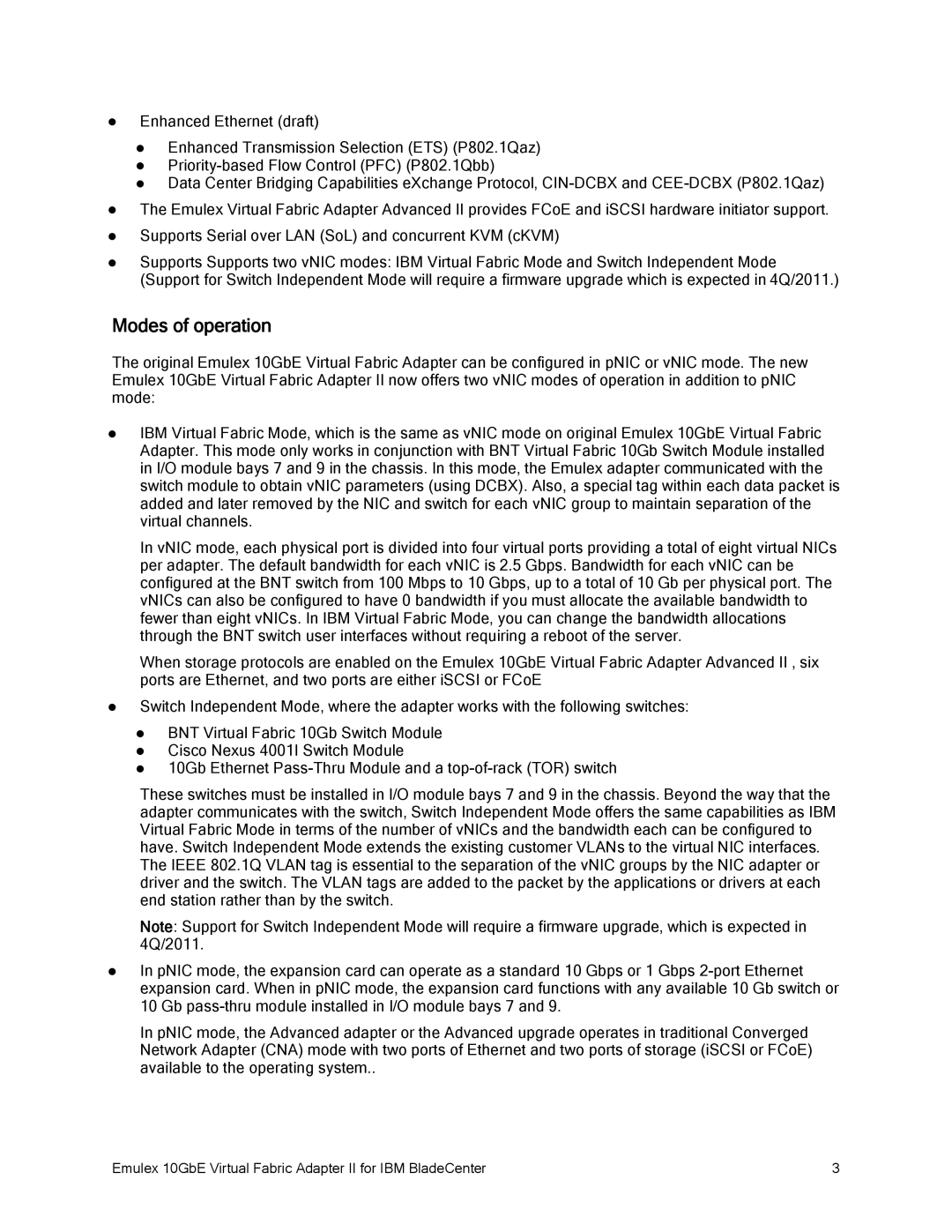zEnhanced Ethernet (draft)
zEnhanced Transmission Selection (ETS) (P802.1Qaz)
z
zData Center Bridging Capabilities eXchange Protocol,
zThe Emulex Virtual Fabric Adapter Advanced II provides FCoE and iSCSI hardware initiator support.
zSupports Serial over LAN (SoL) and concurrent KVM (cKVM)
zSupports Supports two vNIC modes: IBM Virtual Fabric Mode and Switch Independent Mode (Support for Switch Independent Mode will require a firmware upgrade which is expected in 4Q/2011.)
Modes of operation
The original Emulex 10GbE Virtual Fabric Adapter can be configured in pNIC or vNIC mode. The new Emulex 10GbE Virtual Fabric Adapter II now offers two vNIC modes of operation in addition to pNIC mode:
zIBM Virtual Fabric Mode, which is the same as vNIC mode on original Emulex 10GbE Virtual Fabric Adapter. This mode only works in conjunction with BNT Virtual Fabric 10Gb Switch Module installed in I/O module bays 7 and 9 in the chassis. In this mode, the Emulex adapter communicated with the switch module to obtain vNIC parameters (using DCBX). Also, a special tag within each data packet is added and later removed by the NIC and switch for each vNIC group to maintain separation of the virtual channels.
In vNIC mode, each physical port is divided into four virtual ports providing a total of eight virtual NICs per adapter. The default bandwidth for each vNIC is 2.5 Gbps. Bandwidth for each vNIC can be configured at the BNT switch from 100 Mbps to 10 Gbps, up to a total of 10 Gb per physical port. The vNICs can also be configured to have 0 bandwidth if you must allocate the available bandwidth to fewer than eight vNICs. In IBM Virtual Fabric Mode, you can change the bandwidth allocations through the BNT switch user interfaces without requiring a reboot of the server.
When storage protocols are enabled on the Emulex 10GbE Virtual Fabric Adapter Advanced II , six ports are Ethernet, and two ports are either iSCSI or FCoE
zSwitch Independent Mode, where the adapter works with the following switches:
zBNT Virtual Fabric 10Gb Switch Module
zCisco Nexus 4001I Switch Module
z10Gb Ethernet
These switches must be installed in I/O module bays 7 and 9 in the chassis. Beyond the way that the adapter communicates with the switch, Switch Independent Mode offers the same capabilities as IBM Virtual Fabric Mode in terms of the number of vNICs and the bandwidth each can be configured to have. Switch Independent Mode extends the existing customer VLANs to the virtual NIC interfaces. The IEEE 802.1Q VLAN tag is essential to the separation of the vNIC groups by the NIC adapter or driver and the switch. The VLAN tags are added to the packet by the applications or drivers at each end station rather than by the switch.
Note: Support for Switch Independent Mode will require a firmware upgrade, which is expected in 4Q/2011.
zIn pNIC mode, the expansion card can operate as a standard 10 Gbps or 1 Gbps
In pNIC mode, the Advanced adapter or the Advanced upgrade operates in traditional Converged Network Adapter (CNA) mode with two ports of Ethernet and two ports of storage (iSCSI or FCoE) available to the operating system..
Emulex 10GbE Virtual Fabric Adapter II for IBM BladeCenter | 3 |
